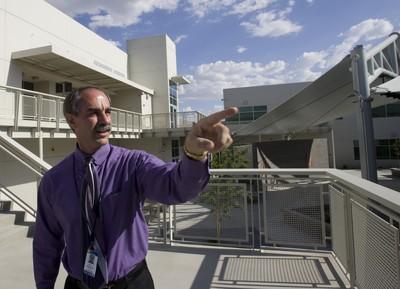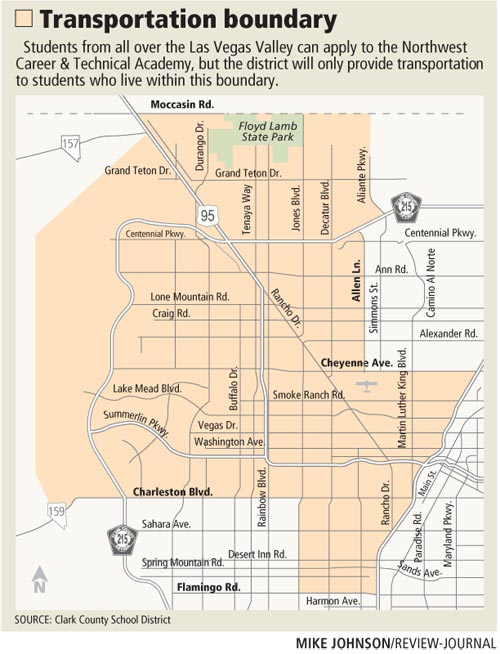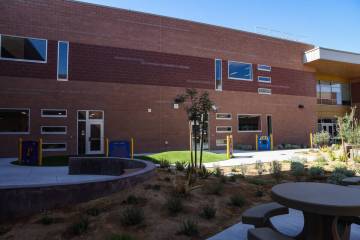Academy will focus on working together
The first thing you might notice about the Northwest Career & Technical Academy is the amphitheater that might be more suited to a college campus. Or the modern, glass-enclosed rooms. Or the coffee shop and state-of-the-art kitchen.
But it's the attention to the small details that tells the story of the new $70 million high school, the school's principal said.
For one, students won't be sitting at individual desks; they'll be doing classwork from long tables instead.
"That was done by design," Principal Frank Pesce said Wednesday. "We want our students working on projects. We want them to collaborate."
Pesce will get the opportunity to develop a team mentality when about 1,000 students pour into the Clark County School District's newest high school next Monday.
The first-year principal, who has worked in the district since 1992, is in charge of opening the specialty high school that focuses on guiding students toward career paths in areas such as medicine, culinary arts and information technology.
Because of high demand, four similar academies will open in the district by the 2009-10 school year.
Superintendent Walt Rulffes said the two similar existing schools in the district, the Southeast Career & Technical Academy, formerly Vo-Tech, and the Advanced Technologies Academy, have produced higher graduation rates and lower dropout rates than district averages for high schools.
Establishing more academies will also allow more choice for high school students, and the schools will have smaller class sizes than traditional high schools, Rulffes said.
The Northwest Academy, on West Tropical Parkway at Durango Drive, will be capped at about 2,000 students and will have a maximum student-teacher ratio of 28 to 1, Pesce said. High schools typically have a ratio of 32 students per teacher.
Rulffes said the public must disavow the notion that such schools are where students who struggle in a traditional high school setting go as a last resort. He said the specialty schools have generally done better than traditional high schools because they attract motivated students who want to be there.
"We don't even want to use the V word anymore," Rulffes said. "It's not vocational anymore. It's career and technical schools. ... It's where the jobs are."
Pesce will open his school with only freshmen and sophomores. Juniors and seniors will be added in the following two school years, Pesce said.
As of Wednesday, his school still had about 100 openings for sophomores in its teacher education, construction, biotech, hospitality, media production and transportation technology programs.
Students were chosen at random from a lottery to attend the school, which is about 225,000 square feet. They'll be coming from 17 middle schools and nine high schools.
About 90 to 95 percent of the students will be bused to the school from neighborhoods mostly in the northwest part of the valley, but which are also in south and central Las Vegas, Pesce said. The small percentage of students from outside this boundary would have to arrange their own transportation, Pesce said.
He said students at his school, which abides by the state's curriculum standards, will take eight classes per year. During freshman year, one of those classes will focus on students' chosen specialization. During the sophomore year, students will have two classes for the year in their specialization, Pesce said.
The Northwest Academy won't offer sports programs to its students, but will offer clubs such as yearbook, dance, student council and national honors society, Pesce said.
Students who are interested in joining teams will have the opportunity to do so at the high school that they are zoned for. Pesce said the school does have basketball and tennis courts and a field with artificial turf that will be used for gym class.
"Our emphasis is developing the whole student," Pesce said. "We're not just developing their minds."
Other amenities at the school include a room that simulates a television station complete with a green screen.
To encourage Pesce's goal of having students collaborate with each other, the school also has eight glass-enclosed "project rooms." The 378-square-foot rooms are meant to encourage students to interact with each other when they are working on projects in and outside of their specialties.
"No other schools have these," Pesce said.
Across from most project rooms will be work stations for teachers with long, horizontal windows where teachers who are working will be visible from hallways.
"We're not hiding from the kids anymore," said Teri Hill-Trumble, the English chairwoman at the school. "It's a very positive model when the kids can see teachers working together."
Hill-Trumble was so enthusiastic about starting the school year, she began setting up her classroom more than a week before teachers were required to begin working.
Hill-Trumble, who has taught in the district for 15 years, said she's "just as excited as the first year I taught."
"There are so many possibilities. We're only limited by our own creativity."




















